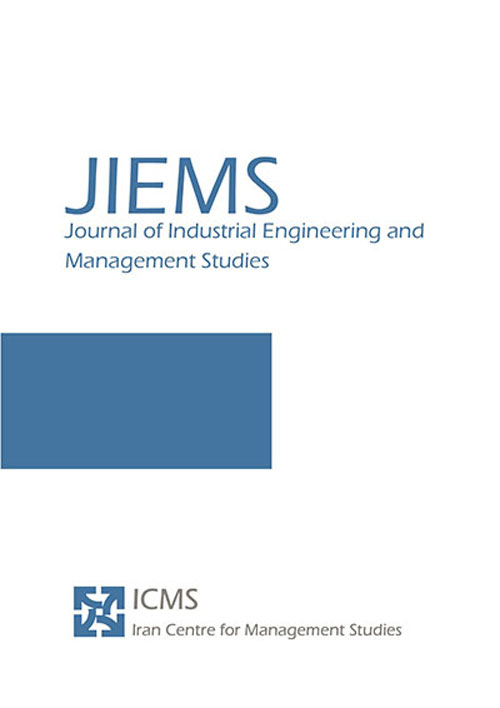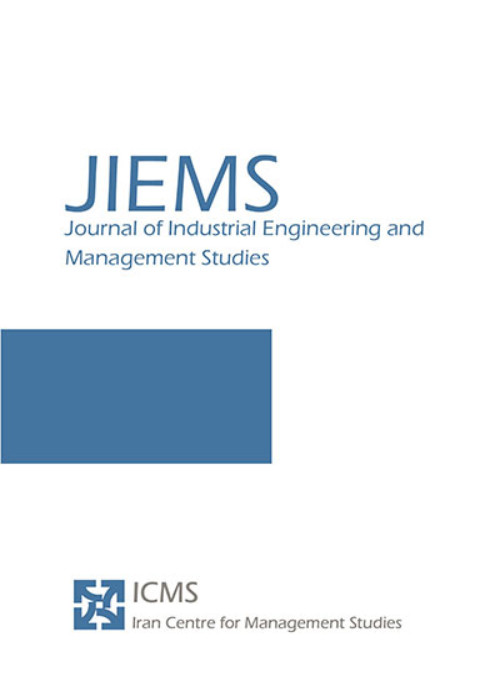فهرست مطالب

Journal of Industrial Engineering and Management Studies
Volume:3 Issue: 2, Summer-Autumn 2016
- تاریخ انتشار: 1396/05/09
- تعداد عناوین: 6
-
-
Pages 1-16CCC-r chart extended approach of CCC charts, is a technique applied when nonconforming items are rarely observed. However, it is usually assumed that the inspection process is perfect in the implementation control charts imperfect inspections may have a significant impact on the performance of the control chart and setting the control limits. This paper first investigates the effect of inspection errors on the formulation of CCC-r chart, then an economic model is presented in the presence of inspection errors to design control chart so that the average cost per item minimized. The r parameter in the chart is optimized with respect to the economic objective function, Modified Consumer Risk, and Modified Producer Risk.Keywords: CCC-r control chart, Average Number of Inspected items, Inspection errors, Economic design of control charts, Analytic hierarchy process
-
Pages 17-32Despite several individual forecasting models that have been proposed in the literature, accurate forecasting is yet one of the major challenging problems facing decision makers in various fields, especially financial markets. This is the main reason that numerous researchers have been devoted to develop strategies to improve forecasting accuracy. One of the most well established and widely used solutions is hybrid methodologies that combine linear statistical and nonlinear intelligent models. The main idea of these methods is based on this fact that real time series often contain complex patterns. So single models are inadequate to model and process all kinds of existing relationships in the data, comprehensively. In this paper, the auto regressive integrated moving average (ARIMA) and artificial neural networks (ANNs), which respectively are the most important linear statistical and nonlinear intelligent models, are selected to construct a set of hybrid models. In this way, three combination architectures of the ARIMA and ANN models are presented in order to lift their limitations and improve forecasting accuracy in financial markets. Empirical results of forecasting the benchmark data sets including the opening of the Dow Jones Industrial Average Index (DJIAI), closing of the Shenzhen Integrated Index (SZII) and closing of standard and poors (S&P 500) indicates that hybrid models can generate superior results in comparison with both ARIMA and ANN models in forecasting stock prices.Keywords: Combination Architecture, Hybrid model, Artificial Neural Networks (ANNs). Auto-regressive Integrated Moving Average (ARIMA), Forecasting Stock Price
-
Pages 33-57Supply chain design has a crucial role in the prosperity and sustainable growth of enterprises. Network and innovation mutual relationship shapes the orientation and design of the supply chain. Networks are means of securing access to the resources, information and support. A number of studies have examined the relationship between networks and innovation, and show a positive relation between them which results in growth. The contingent nature of networking in the literature makes it a complex phenomenon for an entrepreneur to identify his/her optimal position in the web of networks and master it effectively to provide sustainable presence in the market. This paper examines different types of networking in a broad term and innovation in the context of enterprises and shows the interdependency of networking and innovation. An in-depth review of the extant literature and the grounded theory is applied to develop a conceptual framework for elements of the supply chain by exploring the major layers of networks, innovation and their mutual relationship. Based on this model, several studies are reviewed and this paper offers suggestions in order to understand how the network and innovation reciprocal relationship influences performance.Keywords: Supply chain, networks, SME
-
Pages 58-87In this paper, the coordination of pricing and periodic review inventory decisions in a supplier-retailer supply chain (SC) is proposed. In the investigated SC, the retailer faces a stochastic price dependent demand and determines the review period, order-up-to-level, and retail price. On the other hand, the supplier decides on the replenishment multiplier. Firstly, the decentralized and centralized decision making models are established. Afterwards, a quantity discount contract as an incentive scheme is developed to coordinate the pricing and periodic review replenishment decisions simultaneously. The minimum and maximum discount factors, which are acceptable to both SC members, are determined. In addition, a set of numerical examples is conducted to demonstrate the performance of the proposed coordination model. The results demonstrate that the proposed coordination mechanism can improve the profitability of SC along with both the SC members in comparison with the decentralized model. In addition, the results revealed that the proposed incentive scheme is able to achieve channel coordination. Moreover, the coordination model can fairly share the surplus profits between SC members based on their bargaining power.Keywords: supply chain coordination, Periodic review replenishment, pricing, Quantity discount contract
-
Pages 88-106In todays competitive world, the need to supply chain management (SCM) is more than ever. Since the purpose of logistic problems is minimizing the costs of organization to create favorable time and place for the products, SCM seek to create competitive advantage for their organizations and increase their productivity. This paper proposes a new multi-objective model for integrated forward / reverse logistics network including three objective functions which belongs to the class of NP-hard problems. The first objective attempts to minimize the total cost of the supply chain network. The second objective attempts to maximize the customer service level (customer responsiveness) in both forward and reverse networks. The third objective tries to minimize the total number of defects of in raw material obtained from suppliers and thus increase the quality level. To solve the proposed model, the non-dominated sorting genetic algorithm (NSGA-II) and non-dominated ranked genetic algorithms (NRGA) are used. A Taguchi experimental design method was applied to set and estimate the proper values of GAs parameters for improving their performances. Besides, to evaluate the performance of the two algorithms some numerical examples are produced and analyzed with some metrics to determine which algorithm works better. In order to determine whether there is a significant difference between the performances of the algorithms, the one-way ANOVA and Tukey test are used at 0.95 confidence level. Finally, the performance of the algorithms is analyzed and the results are reported.Keywords: supply chain Management, Logistic Network, Non-Dominated Sorting Genetic Algorithm (NSGA-II), Non-dominated Ranked Genetic Algorithms (NRGA)
-
Pages 107-122Data envelopment analysis (DEA) is one of non-parametric methods for evaluating efficiency of each unit. Limited resources in healthcare economy is the main reason in measuring efficiency of hospitals. In this study, a bootstrap interval data envelopment analysis (BIRDEA) is proposed for measuring the efficiency of hospitals affiliated with the Hamedan University of Medical Sciences. The proposed method is capable to consider uncertainty and sampling errors. The inputs of this model include total number of personals, number of medical equipment, and number of operational beds. Also, outputs consist of number of inpatients, number of outpatients, number of special patients, bed-day, and bed occupancy rate. First, we estimate the efficiency by applying original DEA that does not consider any uncertainty and sampling error; then we utilize RDEA that considers uncertainty and after that we use BRDEA that consider both uncertainty and sampling error with an adaptation of bootstrapped robust data envelopment analysis and could be more reliable for efficiency estimating strategies.Keywords: Data Envelopment Analysis, Robust optimization, Hospital management, Bootstrap


